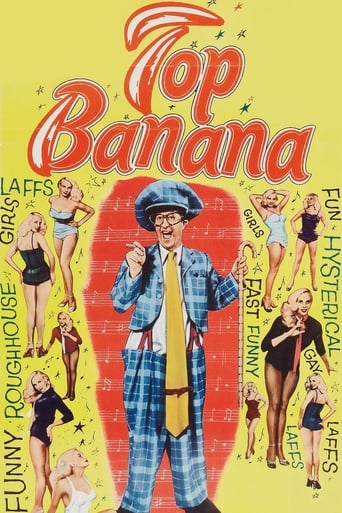

Previous users have done a great job of commenting on this "film." It's definitely B-grade - a poorly filmed Broadway production. Actually, quite a bit of early-50s television is BETTER than this Vaudeville rehash. TCM plays this every once in a while, and I happened to tape it this afternoon. Although I rarely fast-forward through a film, I couldn't resist it with this bomb. Sure, it is great to see Rose Marie as an early version of "Sally" from "The Dick Van Dyke Show," but that's about all it has going for it.....well, that, and the Johnny Mercer score. I'm really surprised at how low-tech this film appears, in production value, as well as color quality.
... View MoreI believe the only current way to truely appreciate this movie is to get the soundtrack of the stage play on disc or CD and listen to it. It will certainly fill in a lot of the gaps and lessen the confusion when the VHS video is viewed. Somewhere I read that "A Word A Day" was never filmed; too bad, as it's a great number. Based on the soundtrack, which has surprisingly good fidelity (especially after listening to the video), one can envision the play, and possibly uncut movie, as having been very enjoyable. So after watching the video, close your eyes and listen to all the outstanding musical numbers on the soundtrack and envision the stage play as it was and movie as it should have been. Let's hope an full length print someday surfaces.
... View MoreAs a record of a type of Broadway entertainment we see very little of nowadays, plus a documentation of classic Vaudeville material presented by the people who actually performed it, this movie should be a little gem.Should be, but it ain't. The version foisted on us by MGM/UA Home Video is a total travesty and completely unrepresentative of the original film. "Top Banana" as released in 1953, had at least 2 more musical numbers, a number of Vaudeville acts (hello, Hogan the Talking Dog), and 3-D sequences(!).There's got to be a complete print of this film out there for us to appreciate the genius of Phil Silvers. The version of this movie put out on VHS is an abomination.To understand why, you have to realize the what was going on at the time of the creation of "Top Banana:" This was a low-budget exploitation flick capitalizing on Phil Silvers' surge in popularity on TV following his winning a Tony award for the original Broadway version of Top Banana. 1950's Hollywood, in it's paranoid fear of television, loves another chance to sneer at cheesy variety programs that seem to be recycling Vaudeville material ad nauseum.OK, it looks like virtually no money is spent on production values: they apparently transported the play, sets, costumes, and all to an L.A. theater and set up a couple of cameras. Sound recording of dialogue is done with little or no technical enhancement, unless we are hearing playback of songs. And yes, the director apparently never heard of a closeup, let alone anything but straight-ahead shots of the cast moving right to left across the screen.But look at what it purports to be: Basically a filmed record of a Broadway musical comedy. Jeez, PBS does it and everyone thinks it's brilliant. Somebody at the studio apparently tried to dress it up by inserting shots of a live audience..."Hey, I get it, Mabel! We are watching a PLAY!" But within the little universe of the movie, it makes no sense, since the audience does not make one peep during the most of the show. Actually with the butchered print, it's hard to follow what was going on. The long takes where Silvers and cast perform straight-ahead old-time comedy are interesting, and make you wish the whole movie was intact.
... View MoreIn 1951, Phil Silvers starred in a Broadway musical comedy satirizing the then-champ of TV, Milton Berle -- his ego, his drive, his anything-for-a-laugh desperation. It ran a year but lost money. That didn't stop producer Albert Zugsmith from filming the show, and I mean filming the show -- at a Los Angeles theater, with audience-reaction shots and no attempt at movie production values. It was filmed in cheap color and 3-D (no 3-D prints survive) and given a limited release.The current print has a vastly reduced running time, with several musical numbers missing. As a movie, it isn't much. But as a curio of a certain kind of stage musical at a certain time in theater history, it's invaluable. The music is loud and brassy, the staging unsubtle, the pace fast. And while Silvers disparages the movie in his autobio, it's a fine documenting of his comic style and energy. The general tackiness of the enterprise (perfunctory song cues, boilerplate romantic subplot, cheesy sets, non-PC attitudes toward women by today's standards) actually add to its period charm. It's also fun seeing a pre-Dick Van Dyke Rose Marie, playing a very similar part.
... View More